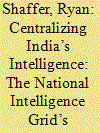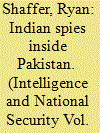| Srl | Item |
| 1 |
ID:
158533


|
|
|
|
|
| Summary/Abstract |
The struggle to ensure information flows to the people who need it while keeping that same information compartmentalized to protect it poses unique problems in the digital age. This effort is further complicated in India where budget constraints, a commitment to democracy, and being a constant target for terrorism tend to severely stretch the security services. In particular, funding for even the country’s Special Forces is problematic and has led to poorly prepared counterterrorism personnel due to limited budgets that prevent the purchase of ammunition for training.
|
|
|
|
|
|
|
|
|
|
|
|
|
|
|
|
| 2 |
ID:
179141


|
|
|
|
|
| Summary/Abstract |
Several times a year, crowds gather at the Hazratbal Shrine near Srinagar to see the imam display a thermometer-like container that purportedly holds Prophet Muhammad’s hair.1 Located close to the summer capital in Jammu and Kashmir, the shrine–mosque complex is a symbol of prestige and famous throughout India. More than that, it has also repeatedly been the site of violent disturbances connected to militants seeking independence from India.2 One of the most tantalizing events surrounding the shrine is a little investigated, but widely retold story about the hair being stolen and returned during the early 1960s. The narrative about the theft from India’s top intelligence officer has been repeated but has not been previously examined from an intelligence studies lens. This article calls for a rethinking of the story and demonstrates how a careful reading of an intelligence officer’s memoir can potentially reveal new facts in light of fictional material.
|
|
|
|
|
|
|
|
|
|
|
|
|
|
|
|
| 3 |
ID:
166779


|
|
|
|
|
| Summary/Abstract |
This article examines India’s historical efforts to spy inside Pakistan from the mid-1960s to the early 1970s. It draws from memoirs of notable Indian spies who were jailed for espionage in Pakistan and spy ‘fiction’ written by former Indian intelligence and military officers who allege their writing is based on actual cases. The article highlights commonalities among Indian spies using the words of Indian officers to better understand human intelligence efforts inside Pakistan. It finds that Indian spies in these books have initially been Hindus or from multi-religious families, from the Indian-Pakistan border and have been poorly treated by the Indian government and its intelligence services.
|
|
|
|
|
|
|
|
|
|
|
|
|
|
|
|
| 4 |
ID:
153169


|
|
|
|
|
| Summary/Abstract |
Little has been written about India’s intelligence capabilities and history, and even less that analyzes key moments of its history. The Indian government restricts public access to information about its intelligence agencies, and its officers have traditionally been discouraged from writing about their work, both by their peers and threats of prosecution. Recently, however, former intelligence officials have defied the norm by writing biographies and making public statements that shed light on this neglected subject.
|
|
|
|
|
|
|
|
|
|
|
|
|
|
|
|
| 5 |
ID:
192072


|
|
|
|
|
| Summary/Abstract |
This article analyses nearly 600 terrorist attacks against healthcare facilities and workers in Africa between 1974 and 2021. It demonstrates there has been a notable increase in the number of terrorist attacks on these targets and explores the different attack modes, targets, and locations. The article describes how the attacks have transformed over the last nearly fifty years, becoming increasingly lethal. Consequently, it calls for scholars, the healthcare sector, governments, and international groups in Africa to recognise these trends and improve counter-measures for preventing and mitigating healthcare facility and worker attacks.
|
|
|
|
|
|
|
|
|
|
|
|
|
|
|
|